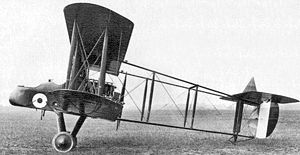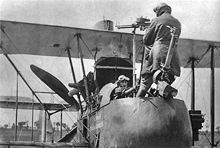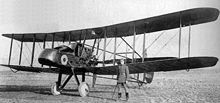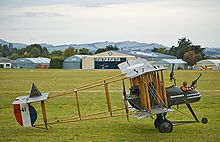Royal Aircraft Factory F.E.2 Video - Picture

|
|
Royal Aircraft Factory F.E.2
F.E.2b

Picture - F.E.2b with "V" type undercarriage
Role: Fighter/Reconnaissance, Night Bomber
Manufacturer: Royal Aircraft Factory
First flight: February 1914
Introduced: September 1915
Retired: 1918
Status: Retired
Primary user: Royal Flying Corps
Produced: 1914- 1918
Number built: 1,939
Variants: F.E.1, Vickers VIM
The Royal Aircraft Factory F.E.2 was a two-seat pusher biplane that was operated as a day and night bomber and as a fighter aircraft by the Royal Flying Corps during the First World War. Along with the single-seat D.H.2 pusher biplane and the Nieuport 11, the F.E.2 was instrumental in ending the Fokker Scourge that had seen the German Air Service establish a measure of air superiority on the Western Front from the late summer of 1915 to the following spring.
Design and development
The F.E.2 (Farman Experimental 2) designation actually refers to three distinct designs - although all were pushers based on the general layout employed by the French aircraft designers, the Farman Brothers.
F.E.2 (1911 version)
The first F.E.2 was designed by Geoffrey de Havilland at the Royal Aircraft Factory in 1911. Although it was claimed that it was a rebuild of the F.E.1 - a pusher biplane designed and built de Havilland before he joined the Factory's staff, it was in fact an entirely new aircraft, with construction completed before the F.E.1 was wrecked in a crash in August 1911. The new aircraft resembled the final form of the F.E.1, with no front elevator, but seated two in a wood and canvas nacelle, and was powered by a 50 hp (37 kW) Gnome rotary engine.
It made its maiden flight on 18 August 1911, flown by de Havilland. It was fitted with floats in April 1912, first flying in this form on 12 April 1912, but was underpowered and its engine was therefore replaced by a 70 hp (52 kW) Gnome, this allowing it to take off carrying a passenger while fitted with floats. Later in the year the F.E.2, refitted with a landplane undercarriage, was modified to carry a Maxim machine gun on a flexible mount in the nose.
F.E.2 (1913 version)
The second F.E.2 was officially a rebuild of the first F.E.2, and may, indeed, have included some components from the earlier aircraft. It was, however, larger and heavier than the 1911 aircraft, with wingspan increasing from 33 ft (10.06 m) to 42 ft (12.80 m) and loaded weight from 1,200 lb (545 kg) to 1,865 lb (848 kg). The new F.E.2 used the outer wings of the B.E.2a, with wing warping instead of ailerons for lateral control, and was powered by a 70 hp Renault engine. It was destroyed when it spun into the ground from 500 ft (150 m) on 23 February 1914, killing the pilot, R. Kemp.
1914 fighter
Work started on another totally new design in mid-1914, with the new type, the F.E.2a, specifically intended as a "fighter", or machine gun carrier - in the same class as the Vickers "Gunbus". The first production order for 12 aircraft was placed "off the drawing board" (i.e. prior to first flight) shortly after the outbreak of the First World War. By this stage, the "pusher" design was becoming obsolete as far as aerodynamic performance was concerned, however, the RFC had not yet solved the problem of firing a machine gun through the propeller of a tractor aircraft (which the Germans were shortly to manage using Anthony Fokker's interrupter gear) and consequently, pushers, with a clear forward field of fire, remained the favoured configuration for fighters.
The F.E.2 was a two-seater with the observer sitting in the nose of the nacelle and the pilot sitting above and behind. The arrangement was described by Frederick Libby, first American ace of World War I as follows:

Picture - An F.E.2d observer demonstrating the use of the rear-firing Lewis gun which required him to stand on his seat.
"When you stood up to shoot, all of you from the knees up was exposed to the elements. There was no belt to hold you. Only your grip on the gun and the sides of the nacelle stood between you and eternity. Toward the front of the nacelle was a hollow steel rod with a swivel mount to which the gun was anchored. This gun covered a huge field of fire forward. Between the observer and the pilot a second gun was mounted, for firing over the F.E.2d's upper wing to protect the aircraft from rear attack ... Adjusting and shooting this gun required that you stand right up out of the nacelle with your feet on the nacelle coaming. You had nothing to worry about except being blown out of the aircraft by the blast of air or tossed out bodily if the pilot made a wrong move. There were no parachutes and no belts. No wonder they needed observers."
The observer was armed with one .303 in Lewis machine gun firing forward on a specially designed, swivelling mount that gave it a very wide field of fire. Later, another Lewis was added, mounted to fire backwards over the top wing - however, the observer was required to stand on his seat in order to fire this weapon, which failed to cover a very large blind spot under the tail. The observer's perch was a precarious one, especially when firing the rear gun, and he was liable to be thrown out of his cockpit, however, his view was excellent in most important directions. The F.E.2 could also carry a small external bomb load.
The first production batch was for 12 of the initial F.E.2a variant, with a large airbrake under the top centre section, and a Green E.6 engine. The first F.E.2a made its maiden flight on 26 January 1915. It was found to be underpowered, and was re-engined with a 120 hp (89 kW) Beardmore liquid-cooled inline engine, as were the other eleven aircraft. The F.E.2a was quickly followed by the main production model, the F.E.2b, again powered by a Beardmore, initially the 120 hp version while later F.E.2bs received the 160 hp (119 kW) Beardmore. The airbrake of the "a" having proved unsatisfactory, it was simply omitted. A total of 1,939 F.E.2b/cs were built. The Royal Aircraft Factory itself built only a few, most construction was by private British manufacturers with G & J Weir, Boulton & Paul Ltd and Ransomes, Sims & Jefferies, the main suppliers.
The F.E.2c was an experimental night fighter and bomber variant of the F.E.2b, the main change being the switching of the pilot and observer positions so that the pilot had the best view for night landings. Two were built in 1916, with the designation being re-used in 1918 for a similar night bomber version of the F.E.2b, which was used by 100 Squadron. In the end, the observer-first layout was retained for the standard aircraft.
The Royal Aircraft Factory was always primarily a research establishment, and other experiments were carried out using F.E.2bs, including the testing of a generator-powered searchlight attached between two .303 inch (7.7 mm) Lewis guns, apparently for night fighting duties.
The final model was the F.E.2d (386 built) which was powered by a Rolls-Royce Eagle engine with 250 hp (186 kW). While the more powerful engine made little difference in maximum speed, especially at low altitude, it did improve altitude performance, with an extra 10 mph at 5,000 ft. The Rolls-Royce engine also improved payload, so that in addition to the two observer's guns, an additional one or two Lewis guns could be mounted to fire forward, operated by the pilot.
While the F.E.2d was replaced by the Bristol Fighter, the older F.E.2b proved an unexpected success as a light tactical night bomber, and remained a standard type in this role for the rest of the war. Its climb rate and ceiling were too poor for it to make a satisfactory night fighter.
Operational history

Picture - F.E.2b with "V" undercarriage.
The F.E.2a entered service in May 1915 with No. 6 Squadron RFC, which used the F.E.2 in conjunction with B.E.2s and a single Bristol Scout, with the first squadron completely equipped with the F.E.2 being 20 Squadron, deploying to France on 23 January 1916. At this stage it served as a fighter/reconnaissance aircraft - eventually about two/thirds of the F.E.2s were built as fighters (816) and one third as bombers (395). The F.E.2b and F.E.2d variants remained in day operations well into 1917 while the "b" continued as a standard night bomber until August 1918. At its peak, the F.E.2b equipped 16 RFC squadrons in France and six Home Defence squadrons in England.
On 18 June 1916, German ace Max Immelmann was killed in combat with F.E.2bs of No. 25 Squadron RFC. The squadron claimed the kill, but the German version of the encounter is either that Immelmann's Fokker Eindecker broke up after his synchronizer gear failed and he shot off his own propeller, or that he was hit by friendly fire from German anti-aircraft guns.

Picture - Rolls-Royce Eagle powered F.E.2d with nose-wheel.
In combat with single-seater fighters, the pilots of F.E.2b and F.E.2d fighters would form what is probably the first use of what later became known as a Lufbery circle (defensive circle). In the case of the F.E.2 - the intention was that the gunner of each aircraft could cover the blind spot under the tail of his neighbour, and several gunners could fire on any enemy attacking the group.
The undercarriage of the F.E.2b/d was particularly well designed - a small nosewheel prevented nose-overs when landing on soft ground, and the effective oleo type shock absorbers were also appreciated by crews landing in rough, makeshift fields. In order to gain a few extra miles an hour the nosewheels were however frequently removed in the field, and some aircraft were fitted with a normal "V" type undercarriages - again in an effort to reduce drag.
By autumn 1916, the arrival of more modern German fighters such as the Albatros D.I and Halberstadt D.II meant that even the F.E.2d was outperformed and, by April 1917, it had been withdrawn from offensive patrols. Despite its obsolescence in 1917, the F.E.2 was still well-liked by its crews for its strength and good flight characteristics and it remained a difficult opponent for even the best German aces. Rittmeister Baron von Richthofen was badly wounded in the head during combat with F.E.2d aircraft in June 1917 - the Red Baron, like most German pilots of the period, classed the F.E.2 as a "Vickers" type, confusing it with the earlier Vickers F.B.5.
Although outclassed as a day fighter, the F.E.2 proved very suitable for use at night, and was used both as a night fighter in home defence squadrons on anti-Zeppelin patrols and as a light tactical night bomber. It was first used as a night bomber in November 1916, with the first dedicated F.E.2b night bomber squadrons being formed in February 1917. F.E.2bs continued to be heavily used as night bombers in eight bomber squadrons until the end of the First World War, with up to 860 being converted to, or built as, bombers. Service as a night fighter was less successful, due to the type's poor climb and ceiling.
F.E.2bs were experimentally fitted with flotation bags for operation over water, and were also used to conduct anti-submarine patrols operating out of the Isle of Grain at the mouth of the Thames River.
A total of 35 aircraft derived from the F.E.2 were sold to China in 1919 by Vickers as Vickers Instructional Machines (VIM), to be used as advanced trainers, having a redesigned nacelle fitted with dual controls and powered by a Rolls-Royce Eagle VIII engine. Although acquired as trainers they were used in battles between Chinese warlords. The last combat operations were those in early 1927, when Zhili clique and Fengtian clique warlords joined their forces to defeat Guominjun. VIMs in the hands of Fengtian clique warlords continued to fly in training missions until their capture by the Japanese in the Mukden Incident, and the new owner soon disposed the obsolete aircraft.

Picture - A restored F.E.2b making its debut on 25 April 2009 at Hood Aerodrome, Masterton.
Notable appearances in media
Derek Robinson's novel War Story is centred around a fictional Hornet Squadron flying the F.E.2b, and later the F.E.2d, giving a realistic, albeit darkly humorous account of flying the fighter in the months leading up to the Battle of the Somme.
In Robert Radcliffe's novel, 'Across the Blood-Red Skies', the narrator is an F.E.2 pilot, and offers a well-researched insight into the skills required in order to fly the aeroplane.
Reproductions
Two reproductions of the F.E.2b, one to full air-worthiness standards and fitted with a genuine Beardmore engine, have been manufactured by The Vintage Aviator Ltd of New Zealand.
Operators
Australia
Australian Flying Corps
Central Flying School AFC at Point Cook, Victoria - One aircraft only.
Australian Flying Corps
Central Flying School AFC at Point Cook, Victoria - One aircraft only.
Central Flying School AFC at Point Cook, Victoria - One aircraft only.
United Kingdom
Royal Flying Corps / Royal Air Force
No. 6 Squadron RAF
No. 11 Squadron RAF
No. 12 Squadron RAF
No. 16 Squadron RAF
No. 18 Squadron RAF
No. 20 Squadron RAF
No. 22 Squadron RAF
No. 23 Squadron RAF
No. 24 Squadron RAF
No. 25 Squadron RAF
No. 28 Squadron RAF
No. 31 Squadron RAF
No. 33 Squadron RAF
No. 36 Squadron RAF
No. 38 Squadron RAF
No. 39 Squadron RAF
No. 51 Squadron RAF
No. 57 Squadron RAF
No. 58 Squadron RAF
No. 78 Squadron RAF
No. 64 Squadron RAF
No. 83 Squadron RAF
No. 90 Squadron RAF
No. 100 Squadron RAF
No. 101 Squadron RAF
No. 102 Squadron RAF
No. 116 Squadron RAF
No. 118 Squadron RAF
No. 131 Squadron RAF
No. 133 Squadron RAF
No. 148 Squadron RAF
No. 149 Squadron RAF
No. 166 Squadron RAF
No. 191 Squadron RAF
No. 192 Squadron RAF
No. 199 Squadron RAF
No. 200 Squadron RAF
No. 246 Squadron RAF
China United States
American Expeditionary Force
Royal Aircraft Factory F.E.2 aces
During its widespread service, four dozen aces used the FE.2 as their mount. Notable aces flying the FE.2 included:
F.E.2b pilot aces
Carleton Main Clement
Chester Stairs Duffus
James Green
Harold Hartney
Victor Huston
Reginald Malcolm
Stephen Price
John Quested
Lancelot Richardson
David Stewart
Noel Webb
Charles Woollven
F.E.2d pilot aces
Donald Cunnell
Harry G. E. Luchford
Reginald Makepeace
George Reid
Guy Reid
Cecil Roy Richards
Frederick Thayre
Richard M. Trevethan
Ace's honours were not reserved solely for FE.2 pilots. Though slightly in the minority in the listings, a score of observers that manned the guns also became aces. The more notable among them are listed below:
F.E.2b observer aces
Giles Blennerhasset - 8
Leslie Court
John Cowell
Leonard Herbert Emsden
Frederick Libby
James Robert Smith
F.E.2d observer aces
William Cambray
Francis Cubbon
Campbell Hoy
Laurence Henry Scott
Thomas Lewis
James Tennant
Specifications (F.E.2b)
Data from Warplanes of the First World War: Fighters, Volume Two
General characteristics
Crew: Two (pilot & observer)
Length: 32 ft 3 in (9.83 m)
Wingspan: 47 ft 9 in (14.55 m)
Height: 12 ft 8 in (3.85 m)
Wing area: 494 ft² (45.9 m²)
Empty weight: 2,061 lb (937 kg)
Loaded weight: 3,037 lb (1,380 kg)
Powerplant: 1x— Beardmore 6-cylinder inline piston engine, 160 hp (119 kW)
Performance
Maximum speed: 80 knots (91.5 mph, 147 km/h)
Service ceiling: 11,000 ft (3,353 m)
Rate of climb: 39 minutes 44 sec to 10,000 ft (3,048 m)
Wing loading: 6.15 lb/ft² (30.1 kg/m²)
Power/mass: 0.053 hp/lb (0.086 W/kg)
Endurance: 3 hours
Armament
Guns:
1 or 2x .303 in (7.7 mm) Lewis gun for observer (one mounted in front and one firing back over the top wing)
1 or 2x .303 in (7.7 mm) Lewis gun sometimes mounted for the pilot's use in the F.E.2d
Bombs: up to 517 lb (235 kg) of bombs
Related development
Royal Aircraft Factory F.E.1
Royal Aircraft Factory F.E.8
Vickers VIM
Comparable aircraft
Vickers F.B.5
Airco DH.1
Bibliography
Andrews C.F. and E.B. Morgan. Vickers Aircraft since 1908. London: Putnam, 1988. ISBN 0-85177-815-1.
Bruce, J.M. "The F.E.2 Series: Historic Military Aircraft, No 3." Flight, 12 December 1952, pp. 724-728.
Bruce, J.M. The Aeroplanes of the Royal Flying Corps (Military Wing). London: Putnam, 1982. ISBN 0-370-30084-X.
Bruce, J.M. Warplanes of the First World War: Fighters, Volume Two. London: Macdonald & Co., 1968. ISBN 0-365-01473-8.
Cheesman, E.F., ed. Fighter Aircraft of the 1914-1918 War. Letchworth, UK: Harleyford, 1960.
Guttman, Jon. Pusher Aces of World War 1 (Aircraft of the Aces). London: Osprey Publishing, 2009. ISBN 978-1846034176.
Hare, Paul R. The Royal Aircraft Factory. London: Putnam, 1990. ISBN 0-85177-843-7.
Jackson, A. J. De Havilland Aircraft since 1909. London: Putnam, 1987. ISBN 0-85177-802-X.
Mason, Francis K. The British Bomber Since 1914. London: Putnam Aeronautical Books, 1994. ISBN 0-85177-861-5.
Mason, Francis K. The British Fighter Since 1912. Annapolis, MD: Naval Institute Press, 1992. ISBN 1-55750-082-7.
Raleigh, Walter. The War In The Air: Being the Story of the Part played in the Great War by The Royal Air Force: Vol I. Oxford: Clarendon Press, 1922.
Taylor, John W.R. "F.E.2b". Combat Aircraft of the World from 1909 to the Present. New York: G.P. Putnam's Sons, 1969. ISBN 0-425-03633-2.
Winchester, Jim. "Royal Aircraft Factory F.E.2." Biplanes, Triplanes and Seaplanes (Aviation Factfile). London: Grange Books plc, 2004. ISBN 1-84013-641-3.
Royal Aircraft Factory F.E.2 Pictures
Living Warbirds: The best warbirds DVD series.
Source: WikiPedia